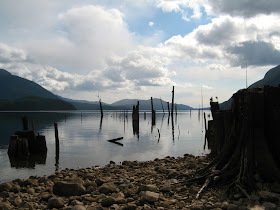 In Wayne's book Up the Main from the Coastal BC Stories series he wrote about a mental (and physical) state he called, "winding down, winding up."
In Wayne's book Up the Main from the Coastal BC Stories series he wrote about a mental (and physical) state he called, "winding down, winding up."When we discovered Powell River and our float cabin, we lived near Los Angeles over 2,000 miles away and were still working at our careers in education. Finding a place where we could "wind down" was very important.
Now that we've immigrated to Canada and settled in our float cabin, the feeling hasn't changed. We travel quite a bit. As nice as it is to go someplace different, that same old feeling of winding down comes over us as we drive down Duncan Street from the airport towards the chuck."When I land at Powell River Airport, via Pacific Coastal or my Piper Arrow, my mental adjustment is major but almost immediate. The change of pace from Los Angeles is extreme, but the adjustment is soothing. As I drive down the hill from the airport, the modification of my attitude is complete the moment I sight the chuck (ocean).
In the other direction, arriving in Los Angeles, the adjustment is completely different. Winding down is quick and simple. Winding up is a major battle. ... The pace is frantic."
Do you have a place you love to wind down? Let's hear about it. -- Margy
















































